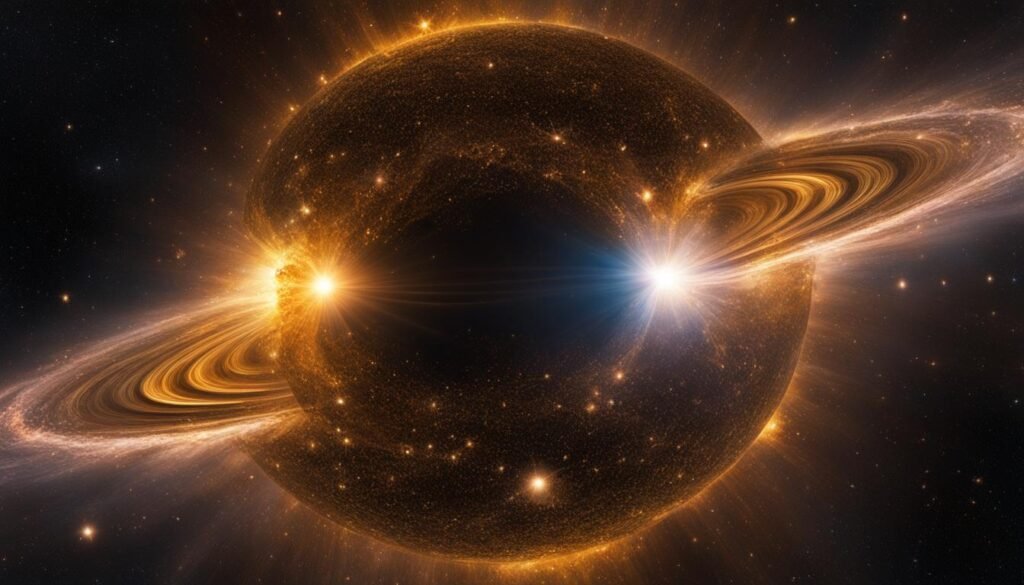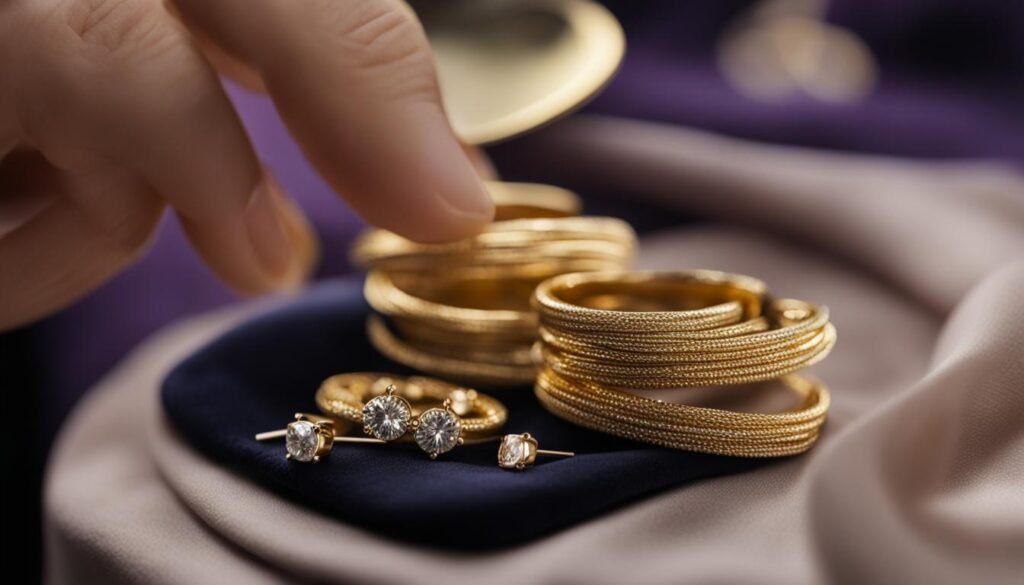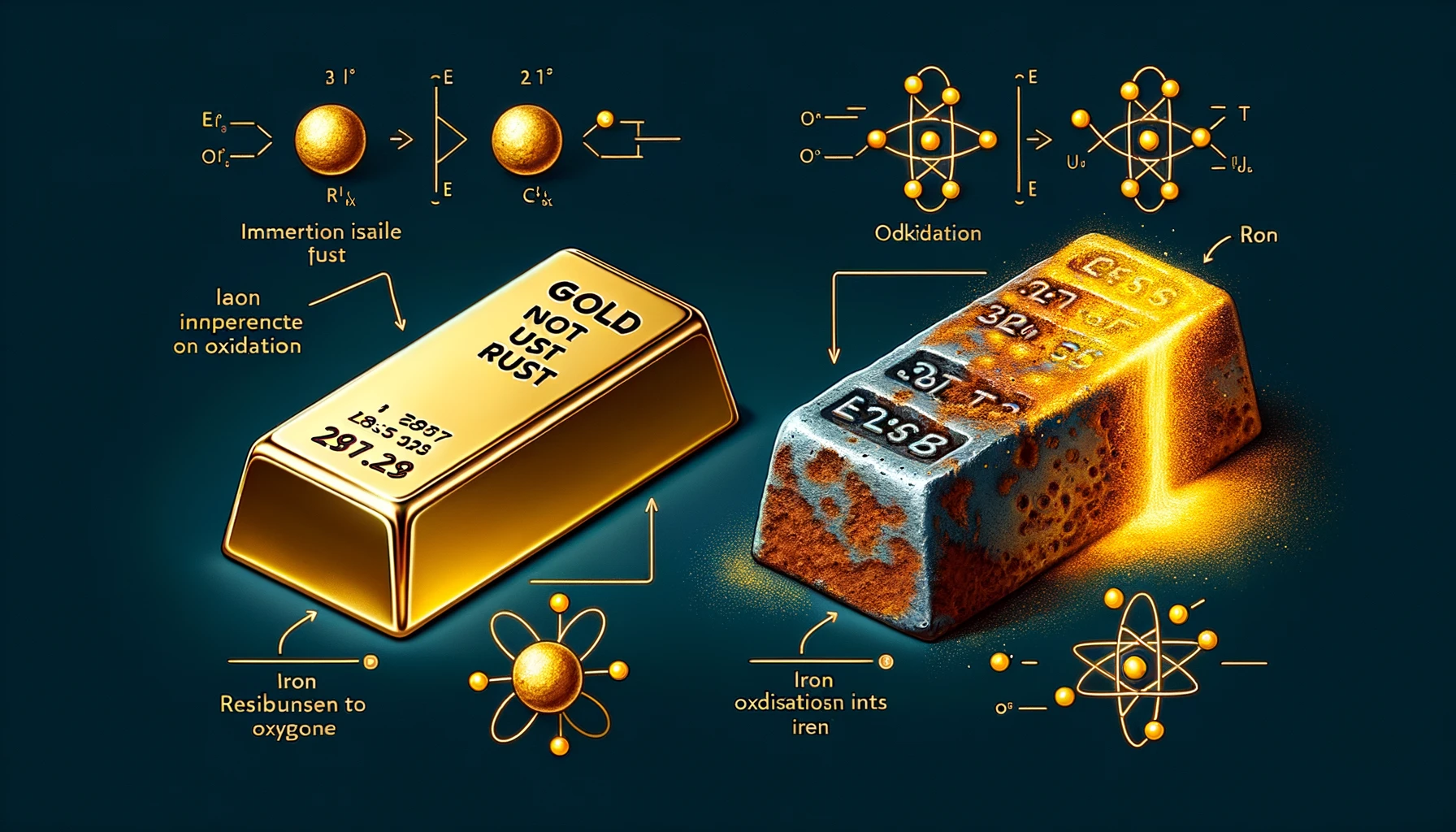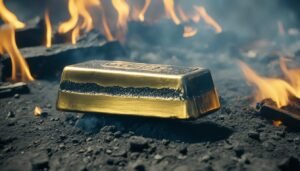Gold is a precious metal that has been valued for its beauty and rarity for centuries.
But can gold rust like other metals?
In this article, we will explore the truth behind whether gold can rust and provide tips on how to maintain its everlasting shine. Using factual data, we will uncover the science behind gold’s resistance to corrosion and the factors that can affect its appearance over time.
Key Takeaways about Can Gold Rust
- Gold does not rust due to its nonreactive nature.
- White gold may show different shades over time, but it is not tarnish.
- Understanding the formation process of gold enhances its appreciation.
- Proper care and cleaning can help maintain the shine of gold.
- Gold’s timeless allure and enduring value have captivated humans for centuries.
The Fascinating Process of Natural Gold Formation – Explained in Detail
Gold formation is a complex and fascinating process that involves a variety of geological processes. From hydrothermal and magmatic processes to sedimentary deposition, gold can form in various ways. Factors such as pressure, temperature, and the presence of other minerals also play a role in the formation of gold deposits. Understanding these processes is crucial for identifying and extracting gold.
One of the key processes in gold formation is hydrothermal activity. In this process, hot water carrying dissolved minerals, including gold, moves through fractures in the Earth’s crust. As the water cools, the minerals precipitate out and form veins of gold. This is why gold deposits are often found in regions with active volcanoes or near fault lines.
Another important process is magmatic activity. When magma, a molten rock, cools and solidifies, it can contain gold and other precious metals. As the magma crystallizes, the gold particles are concentrated and can form deposits. These deposits are often found in igneous rocks such as granite and can be extracted through mining.
| Geological Process | Gold Formation |
|---|---|
| Hydrothermal Activity | Hot water carrying dissolved minerals, including gold, moves through fractures in the Earth’s crust. As the water cools, the minerals precipitate out and form veins of gold. |
| Magmatic Activity | When magma cools and solidifies, it can contain gold. As the magma crystallizes, the gold particles are concentrated and can form deposits. |
| Sedimentary Deposition | Gold particles are transported by rivers and deposited in sedimentary environments. Over time, these particles can accumulate and form placer deposits. |
In addition to these processes, gold can also be deposited through sedimentary processes. Gold particles, eroded from rocks by weathering and transported by rivers, can settle in sedimentary environments. Over time, these particles can accumulate and form placer deposits, which are often found in riverbeds or on beaches.
Overall, the process of natural gold formation is a fascinating journey involving hydrothermal activity, magmatic processes, and sedimentary deposition. By understanding these geological processes and the factors that contribute to gold formation, we can gain valuable insights into the extraction and identification of this precious metal.
The Importance of Pressure and Temperature in Gold Formation
Pressure and temperature play a crucial role in the formation of gold. Understanding how these factors affect gold solubility and the formation of veins and nuggets can provide valuable insights into the geological processes involved.

Higher pressure and temperature conditions decrease the solubility of gold in water, causing it to precipitate out and form veins or nuggets. This explains why gold deposits are often found in regions with high temperatures and pressures, such as near volcanic activity or deep underground.
Table:
| Pressure (kPa) | Temperature (°C) | Gold Solubility (mg/L) |
|---|---|---|
| 10 | 25 | 0.02 |
| 50 | 100 | 0.01 |
| 100 | 200 | 0.005 |
| 200 | 400 | 0.002 |
Comparing Gold Solubility at Different Pressure and Temperature Conditions
The table above illustrates the relationship between pressure, temperature, and gold solubility. As pressure and temperature increase, the solubility of gold decreases. This reduction in solubility leads to the precipitation of gold from water, leading to the formation of veins or nuggets.
The Role of Geological Processes in Gold Formation
Geological processes play a crucial role in the formation of gold deposits. These processes include hydrothermal, magmatic, and sedimentary processes, each contributing to the deposition of gold in different ways.
The Hydrothermal Process
Hydrothermal processes involve hot water and steam dissolving gold and other minerals from rocks deep within the Earth’s crust. As this mineral-rich water rises towards the surface, it cools down, causing the dissolved gold to precipitate out and form veins. These veins can span vast distances and contain significant amounts of gold.

The Magmatic Process
Magmatic processes occur when gold is carried in magma, the molten rock beneath the Earth’s surface. As the magma cools and solidifies, it can trap gold and other minerals within the resulting igneous rocks. Over time, erosion and weathering expose these rocks, bringing gold closer to the surface where it can be discovered.
The Sedimentary Process
Sedimentary processes involve the transportation and deposition of gold particles by rivers. As rivers flow, they carry small grains of gold, which can accumulate in sedimentary environments such as riverbeds and deltas. Over time, the sediment is compacted and hardened, forming sedimentary rocks that contain gold. These deposits are known as placer deposits and are often the target of gold panning and mining activities.
By understanding these geological processes, geologists and prospectors can identify potential areas for gold exploration and extraction. The interplay of hydrothermal, magmatic, and sedimentary processes creates a diverse range of gold deposits throughout the world, each with its own unique characteristics and challenges for discovery.
| Geological Process | Formation Mechanism | Examples of Gold Deposits |
|---|---|---|
| Hydrothermal | Hot water and steam dissolve gold from rocks and precipitate it in veins | Carlin-type deposits, epithermal veins |
| Magmatic | Gold is carried in magma and trapped in solidified rocks | Porphyry deposits, skarn deposits |
| Sedimentary | Gold particles are transported and deposited by rivers, forming placer deposits | Placer deposits, alluvial deposits |
Debunking the Myth of Gold Tarnish
Many people believe that gold tarnishes like other metals, but this is simply not true. Gold has a nonreactive nature, which means it does not react with oxygen, moisture, or sulfur to form tarnish. The idea of gold tarnish often arises when white gold jewelry starts to show patches of different shades over time. However, this is not tarnish, but rather the natural color of the metal showing through the rhodium plating.
The misconception of gold tarnish on white gold jewelry stems from the wearing off of the thin layer of rhodium plating. Over time, the rhodium coating can fade, revealing the warmer tones of the white gold underneath.
To debunk the myth of gold tarnish, it’s important to understand that white gold is not a pure metal. It is an alloy made by mixing gold with other metals such as silver, palladium, or nickel. These alloys have a slightly yellowish color, which is why white gold is often plated with rhodium to achieve a bright white appearance. While the rhodium plating can wear off over time, it does not indicate tarnish. Instead, it allows the natural color of the white gold to shine through.
To summarize, gold does not tarnish due to its nonreactive nature. The patches of different shades that can appear on white gold jewelry are not tarnish but the natural color of the metal showing through the rhodium plating. Understanding this can help you maintain the beauty of your gold jewelry and appreciate its true nature.
Table: Comparing Gold Tarnish with White Gold’s Natural Color
| Gold Tarnish | White Gold’s Natural Color | |
|---|---|---|
| Explanation | Result of oxidation and corrosion | Reveals the true color of white gold |
| Causes | Reaction with oxygen, moisture, or sulfur | Wearing off of rhodium plating |
| Appearance | Dull, discolored surface | Warmer tones of white gold |
| Solution | Cleaning and polishing | Re-plating with rhodium or embracing the natural color |
Why Gold Doesn’t Rust – The Science Behind Corrosion Resistance
Gold’s exceptional resistance to corrosion can be attributed to its nonreactive nature. Unlike metals such as copper and silver, gold does not undergo oxidation when exposed to oxygen or moisture. This is because gold does not readily share electrons with other elements, making it highly stable and unreactive.
When metals like iron rust, they undergo a chemical reaction with oxygen, resulting in the formation of iron oxide. However, gold’s electron-sharing properties prevent it from reacting with oxygen, moisture, or sulfur, which are the main causes of rust in other metals.
Gold’s nonreactive nature makes it highly desirable for various applications, including jewelry, electronics, and aerospace technology. Its resistance to corrosion ensures that gold retains its beautiful appearance and remains unaffected by environmental factors over time.
Factors Contributing to Gold’s Corrosion Resistance
Several factors contribute to gold’s exceptional corrosion resistance:
- Nonreactive nature: Gold’s inability to readily share electrons with other elements prevents it from undergoing oxidation and corrosion.
- Purity: Pure gold, with a high percentage of gold content, is more resistant to corrosion compared to alloys that contain other metals.
- Low reactivity with sulfur: Gold’s low reactivity with sulfur compounds further enhances its corrosion resistance.
Gold’s resistance to rust and corrosion is not only a scientific wonder but also a testament to its enduring beauty and value. Its nonreactive nature allows us to appreciate its luster and shine for generations to come.
The Rarity of Gold and Its Scarcity in Earth’s Crust
Gold is a precious metal that holds immense value and allure. One of the factors that contribute to its desirability is its rarity. Gold is scarce in Earth’s crust, making it a highly sought-after commodity. Its limited presence adds to its intrinsic value and makes it a symbol of wealth and prestige.
Geological estimates suggest that the majority of the world’s gold reserves are buried deep beneath the Earth’s surface. While gold is present in various concentrations throughout the planet, the density of gold causes it to sink towards the core. As a result, the amount of gold available near the surface is relatively low, making it harder to find and extract.
Understanding the scarcity of gold is essential for appreciating its worth. The limited supply of this precious metal ensures that its value remains stable and enduring. As demand for gold continues to rise, the pursuit of new gold deposits becomes increasingly important. Explorations and mining operations focus on uncovering hidden reserves and maximizing the use of existing resources.
| Country | Gold Reserves (metric tons) |
|---|---|
| United States | 8,133.5 |
| Germany | 3,364.5 |
| Italy | 2,451.8 |
Table: Top Countries with the Highest Gold Reserves
As the table shows, countries such as the United States, Germany, and Italy are among those with the highest gold reserves. These countries have recognized the value of gold and have made efforts to accumulate and safeguard their holdings. The strategic accumulation of gold reserves acts as a hedge against economic uncertainties and provides stability to their economies.
Conclusion
Gold’s scarcity in Earth’s crust underscores its value and desirability. The limited availability of this precious metal contributes to its enduring allure and makes it a symbol of wealth and prosperity. Understanding the geological estimates and the distribution of gold reserves allows us to appreciate the rarity of gold and the efforts required to extract and utilize this precious resource.
Gold Formation in Supernova Explosions and Stellar Processes
Gold, the precious metal that captivates us with its shimmering beauty, has a truly cosmic origin. It is not merely a product of Earth’s geological processes, but rather a result of spectacular stellar phenomena. Gold formation can be traced back to the incredible forces unleashed during supernova explosions.
When a massive star reaches the end of its life cycle, it undergoes a cataclysmic explosion known as a supernova. During this awe-inspiring event, the intense heat and pressure generate a cascade of nuclear reactions. These reactions cause lighter elements in the star’s core to fuse together, ultimately creating heavier elements like gold.
Stellar nucleosynthesis is the process by which gold and other heavy elements are formed. As stellar fusion occurs, the star’s core becomes enriched with newly synthesized elements, including gold. When the star explodes as a supernova, these elements are released into the vastness of space, where they eventually coalesce to form new celestial objects, including planets like our own.
| Process | Explanation |
|---|---|
| Supernova Explosion | A massive star reaches the end of its life cycle and undergoes a powerful explosion. |
| Nuclear Reactions | The intense heat and pressure within the star’s core trigger nuclear fusion reactions, leading to the formation of heavier elements, including gold. |
| Stellar Nucleosynthesis | The fusion of lighter elements in the star’s core produces heavier elements like gold. |
| Release into Space | The newly synthesized gold and other heavy elements are released into space during the explosion, where they become part of the cosmic landscape. |
| Formation of Planets | Over time, these cosmic elements come together to form new celestial objects, including planets like Earth. |
So, the next time you gaze upon a piece of gold jewelry or marvel at its radiant allure, remember that it originated from the fiery depths of a dying star. Gold’s cosmic journey, from a supernova explosion to the formation of our planet, is a testament to the enduring connection between the universe and our precious metals.

Uncovering the Hidden Gold in Neutron Star Collisions
Neutron star collisions are astrophysical events of extraordinary magnitude that hold the key to the creation of heavy elements, including gold. These cosmic collisions generate immense energy and release gravitational waves, which were first detected in 2017. The detection of gravitational waves confirmed the long-held hypothesis that neutron star mergers are responsible for the synthesis of precious elements in the universe.
Gravitational waves are ripples in the fabric of spacetime caused by the acceleration of massive objects. When two neutron stars collide, they create a cataclysmic explosion that sends gravitational waves rippling through the cosmos. These waves carry valuable information about the nature of the collision and the elements produced in the process. Scientists analyze these gravitational wave signals to understand the composition and origin of the heavy elements, such as gold, that are formed in these extraordinary events.
The intense temperature and pressure generated during a neutron star collision create the ideal conditions for heavy element synthesis. Elements heavier than iron, including gold, can only form under such extreme circumstances. The fusion of atomic nuclei in the extreme environment of a neutron star collision leads to the creation of new and rare elements. Through the study of these cosmic events and the analysis of gravitational wave data, scientists are unraveling the mysteries surrounding the formation of gold in the universe.
| Gravitational Waves and Gold Formation | Key Insights |
|---|---|
| Neutron star collisions produce gravitational waves. | Gravitational wave detection confirmed the role of these events in the synthesis of gold. |
| Gravitational waves carry valuable information about the nature of the collision and the elements produced. | Scientists analyze gravitational wave signals to understand the composition and origin of heavy elements. |
| Neutron star collisions create the extreme conditions necessary for heavy element synthesis. | The fusion of atomic nuclei in these events leads to the formation of rare elements like gold. |
Debunking White Gold Tarnish – Understanding the Natural Color
If you’ve ever noticed patches of different shades on your white gold jewelry over time, you might be wondering if it’s tarnish. The truth is, white gold doesn’t actually tarnish like other metals. The slight color variation is due to the natural color of the white gold showing through the rhodium plating.
White gold jewelry is commonly plated with rhodium to achieve a bright white appearance. However, this thin layer of rhodium can wear off over time, revealing the slightly warmer tones of the white gold underneath. This can give the impression of tarnish, but it’s important to understand that it’s simply the natural color of the metal.
To maintain the bright, white appearance of your white gold jewelry, you may choose to have it re-plated with rhodium periodically. However, embracing the natural color of white gold is another option that some individuals prefer. By doing so, you can avoid the need for regular re-plating and enjoy a unique and warm appearance that sets your jewelry apart.
In conclusion, white gold does not tarnish. The patches of different shades that may appear over time are not tarnish, but rather the natural color of the white gold showing through the rhodium plating. Whether you choose to embrace the natural color or opt for rhodium plating, understanding the true nature of white gold can help you make informed decisions about caring for and enjoying your jewelry.
Embracing the Natural Color of White Gold – Pros and Cons
While rhodium plating is a popular choice for achieving a bright white appearance in white gold jewelry, some individuals prefer to embrace the natural color of white gold. This decision comes with its own set of pros and cons, offering a unique and warm alternative to the traditional rhodium-plated look.
One of the advantages of embracing the natural color of white gold is the avoidance of regular re-plating. Over time, rhodium plating can wear off, necessitating the need for re-plating to maintain the bright white appearance. By choosing the natural color, you eliminate the need for this ongoing maintenance, saving both time and money.
Additionally, embracing the natural color of white gold allows for a distinct and warm aesthetic. The natural hue tends to have a slightly warmer tone than rhodium-plated white gold, adding a unique character to the jewelry piece. This can be especially appealing for those who prefer a more organic and earthy look.
However, it’s important to consider that the natural color of white gold may show patches of different shades over time as the rhodium plating wears off. This is not tarnish, but rather the natural color of the metal showing through. If you prefer a consistently bright white appearance, rhodium plating may be the better option for you.
Pros and Cons of Embracing the Natural Color of White Gold:
| Pros | Cons |
|---|---|
| Eliminates the need for regular re-plating | Patches of different shades may develop over time |
| Adds a unique and warm aesthetic | Lacks the consistently bright white appearance of rhodium-plated white gold |
Ultimately, the decision of whether to embrace the natural color of white gold or opt for rhodium plating depends on your personal preferences and priorities. Consider the factors that matter most to you, such as maintenance requirements, desired aesthetic, and budget, to make an informed choice that reflects your individual style.
Maintaining the Shine of Gold – Care and Cleaning Tips
Taking proper care of your gold jewelry is essential to maintain its everlasting shine. While gold is resistant to rust and tarnish, it can still lose its luster over time due to dirt, oils, and other environmental factors. By following these simple care and cleaning tips, you can ensure that your gold pieces continue to shine bright:
Avoid Harsh Chemicals
When cleaning your gold jewelry, it is important to avoid using harsh chemicals that can damage the metal. Instead, use a mild soap or detergent mixed with warm water and gently scrub your jewelry with a soft-bristle toothbrush. Rinse thoroughly and pat dry with a clean, lint-free cloth.
Store Properly
Proper storage is key to preventing scratches and other damage to your gold jewelry. When not wearing your gold pieces, store them in a separate compartment of a jewelry box or in individual soft pouches to prevent contact with other jewelry. This will help maintain the shine and prevent any unwanted abrasion.
Regular Cleaning
Regular cleaning is essential to remove accumulated dirt and oils from your gold jewelry. You can use a jewelry cleaning solution specifically designed for gold or follow the mild soap and warm water method mentioned earlier. Gently clean each piece, paying attention to intricate details, and rinse thoroughly before drying.
| Cleaning Method | Ingredients | Instructions |
|---|---|---|
| Mild Soap and Warm Water | Mild soap or detergent, warm water |
|
| Jewelry Cleaning Solution | Jewelry cleaning solution for gold |
|
By following these care and cleaning tips, you can ensure that your gold jewelry retains its shine and remains a cherished piece for years to come. Remember to also avoid wearing your gold jewelry while engaging in activities that may expose it to harsh chemicals, excessive heat, or rough surfaces. With proper care, your gold pieces will continue to dazzle and captivate.

The Value of Gold and its Enduring Appeal
Gold has held a special place in human civilization for thousands of years. Ancient civilizations across the globe treasured gold for its intrinsic beauty and rarity, as well as for its symbolic significance. The enduring popularity of gold is deeply rooted in our emotional connection to this precious metal.
From the ancient Egyptians who adorned their pharaohs with gold jewelry to the Aztecs who fashioned intricate golden masks, gold has been valued for its ability to elevate the status and wealth of its owners. The captivating allure of gold lies not only in its physical attributes but also in the sense of power and prestige it conveys.
“Gold is the universal symbol of wealth and success. It has the ability to evoke feelings of luxury and grandeur, making it highly coveted and prized.”
Furthermore, gold’s enduring appeal can be attributed to its remarkable scarcity. While there are other precious metals, none possess the same level of rarity as gold. Its limited presence in the Earth’s crust and the difficulty of extracting it from the depths of the planet have contributed to its intrinsic value.
Today, gold continues to be a sought-after investment, a symbol of love and commitment in the form of jewelry, and a medium of exchange in the global economy. Its enduring popularity is a testament to its timeless beauty, rich history, and the emotional connection it evokes in people across cultures and generations.

| Key Points | Explanation |
|---|---|
| Symbol of Wealth | Gold’s association with wealth and success has made it universally coveted. |
| Rarity | Gold’s scarcity in the Earth’s crust adds to its intrinsic value. |
| Historical Significance | Ancient civilizations treasured gold for its beauty and symbolism. |
| Emotional Connection | Gold evokes powerful emotions and is often passed down through generations. |
Conclusion
In conclusion, gold does not rust like other metals. Its nonreactive nature and resistance to corrosion contribute to its enduring beauty and value. Gold’s ability to maintain its shine over time is a testament to its exceptional durability. While white gold may show patches of different shades over time due to the wearing of rhodium plating, this is not tarnish, but rather the natural color of the metal showing through.
Understanding the formation process of gold, its scarcity, and the care required to maintain its shine can enhance our appreciation for this precious metal. From its creation in stellar processes to its limited presence in Earth’s crust, gold’s rarity and timeless allure make it a cherished and sought-after material.
Whether you embrace the natural color of gold or opt for rhodium plating to achieve a bright white appearance, the enduring appeal of gold remains unchanged. Its rich history, aesthetic beauty, and value make it a symbol of wealth, luxury, and enduring love. So, whether you wear a gold necklace, ring, or bracelet, let gold’s timeless allure shine brightly in your life.
FAQ about Can Gold Rust
Can gold rust like other metals?
No, gold does not rust. Its nonreactive nature and resistance to corrosion make it highly durable.
How is gold formed naturally?
Gold is formed through a variety of geological processes, including hydrothermal, magmatic, and sedimentary processes.
What role do pressure and temperature play in gold formation?
Higher pressure and temperature conditions cause gold to precipitate out and form veins or nuggets.
What are the key geological processes involved in gold formation?
Gold formation can occur through hydrothermal processes, magmatic processes, and sedimentary processes.
Does gold tarnish?
No, gold does not tarnish. Any discoloration on white gold jewelry is due to the wearing off of rhodium plating.
Why is gold highly resistant to corrosion?
Gold’s nonreactive nature prevents it from reacting with oxygen, moisture, or sulfur, making it highly stable.
How rare is gold?
Gold is rare due to its scarcity in the Earth’s crust and its tendency to sink towards the planet’s core.
How is gold formed in stars?
Gold is produced through stellar processes such as supernova explosions and neutron star collisions.
Does white gold tarnish?
No, white gold does not tarnish. The wearing off of rhodium plating may lead to a change in appearance, but it is not tarnish.
What are the pros and cons of embracing the natural color of white gold?
Embracing the natural color avoids the need for re-plating but results in a slightly warmer tone.
How should gold be cared for and cleaned?
Regular cleaning and avoiding harsh chemicals or abrasive materials can help maintain the shine of gold.
Why is gold highly valued and enduringly popular?
Gold’s beauty, rarity, and unchanging nature have made it highly valued throughout history.








